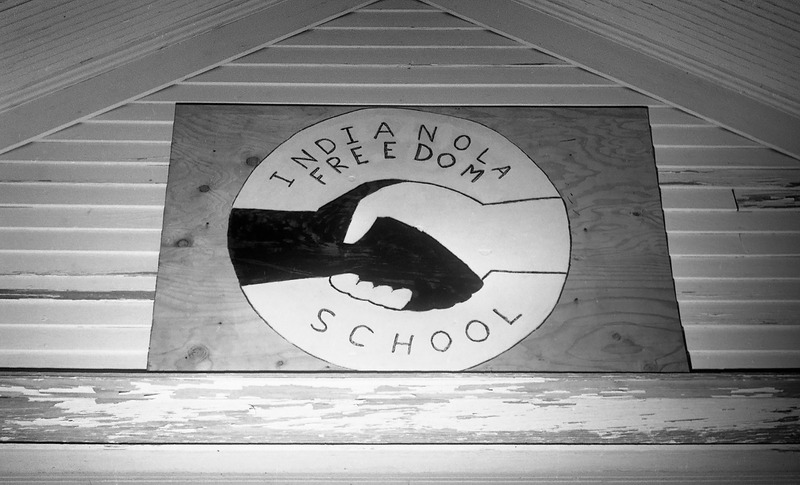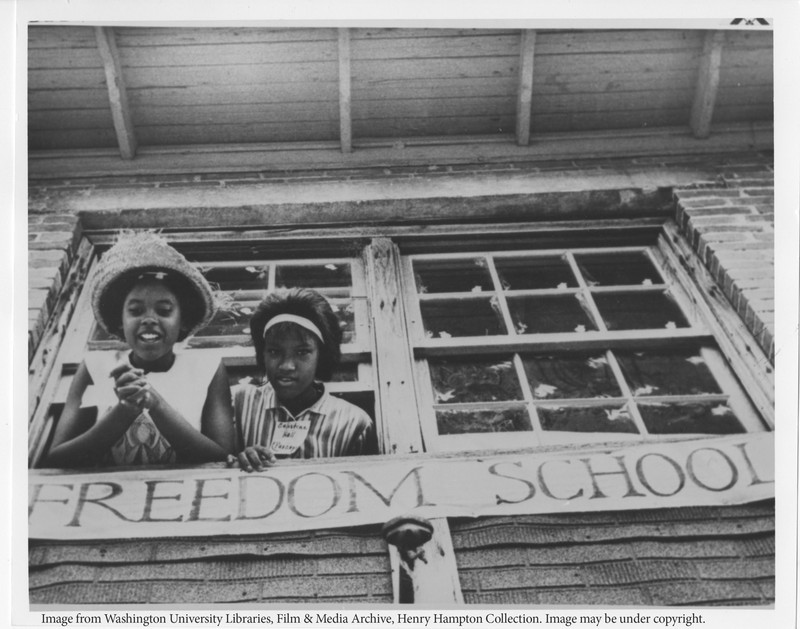During the 1964 Freedom Summer campaign Richard Beymer captured a photo of a Freedom School sign in the Mississippi Delta. Beymer was one of many professional photographers hired by the Council of Federated Organizations (COFO), which was made up of the leading youth activist organizations of the 1960s (Cox 28). Freedom Schools were made possible by these organizations, their efforts, and their financial support (Bynum 53).
The sign displays not only racial integration but also racial unity. The simple circular icon, painted on the center of a plywood board is a black hand shaking a white hand. The text, “INDIANOLA-FREEDOM–SCHOOL” runs across the border of the white circle. It is impossible to tell whether it is on the interior or the exterior of the building. However, it is placed on the façade of a post-lintel beam structure, which seems to indicate that the sign is placed on a part of the building that is visible to its guests. The icon in the photograph promotes one of the main goals of SNCC: racial equality and integration.
During Freedom Summer, white volunteers stayed with black local Mississippi residents, a taboo practice in the Delta region. Housing white volunteers with black locals during the Freedom Summer is another way CORE imposed a new ideal of racial equality in a racially divided region (Bynum 116).
The local white citizens considered the Freedom Summer to be an “invasion” since student volunteers of the COFO were a threat to white dominance (Bynum 127). Those threatened by the Freedom Schools started counter organizations, such as The Citizen’s Council, in response to the COFO. The Citizen’s Council was committed to white dominance, control, and political power in the Mississippi Delta. The new ideals and morals that organizations like SNCC, CORE, and SCLC were attempting to impose affected the local population and its residents. In this case, the sign for the school is less relevant than the icon it displays. This photo encapsulates the new ideals volunteers were fighting for as well as the efforts against the racial barriers that existed in the Mississippi of 1964.
The summer of 1964 was dedicated to direct action protests. Students, teachers, ministers, and activists volunteered to travel to the Mississippi Delta, a part of the state where there were more black than white residents. Even though blacks made up the majority of the population, whites maintained oppressive political control. To counteract the status quo, Freedom Schools taught classes in black history, reading, writing, and arithmetic and, by night, served as spaces for political meetings and voter registration campaigning. Voter registrations would lead to a rise in black political power. With new-elected officials in office willing to oppose the Citizen’s Council, white and black social practices would soon change (Blackside Season 1 Episode 5).
In Robert Venturi’s essay, "Complexity and Contradiction in Architecture," he focuses on the visual language of architectural design. This photograph is a glimpse at the freedom school’s architectural language. Venturi states: “a valid architecture evokes many levels of meaning and combinations of focus: its space and its elements become readable and workable in several ways at once” (Venturi 385).
Assuming the Indianola Freedom School is ‘valid architecture,’ the photograph of the Freedom School sign shows how the presence of these out-of-state student volunteers challenged many aspects of the social and racial structures in Mississippi.
Beymer’s photograph and many others in his portfolio are primary sources of the direct action protests during the 1964 Freedom Summer. The composition of this particular photo and its importance represents the volunteers’ relationship with black locals and their goal of breaking down the nefarious racial dynamics of a burdened region.

